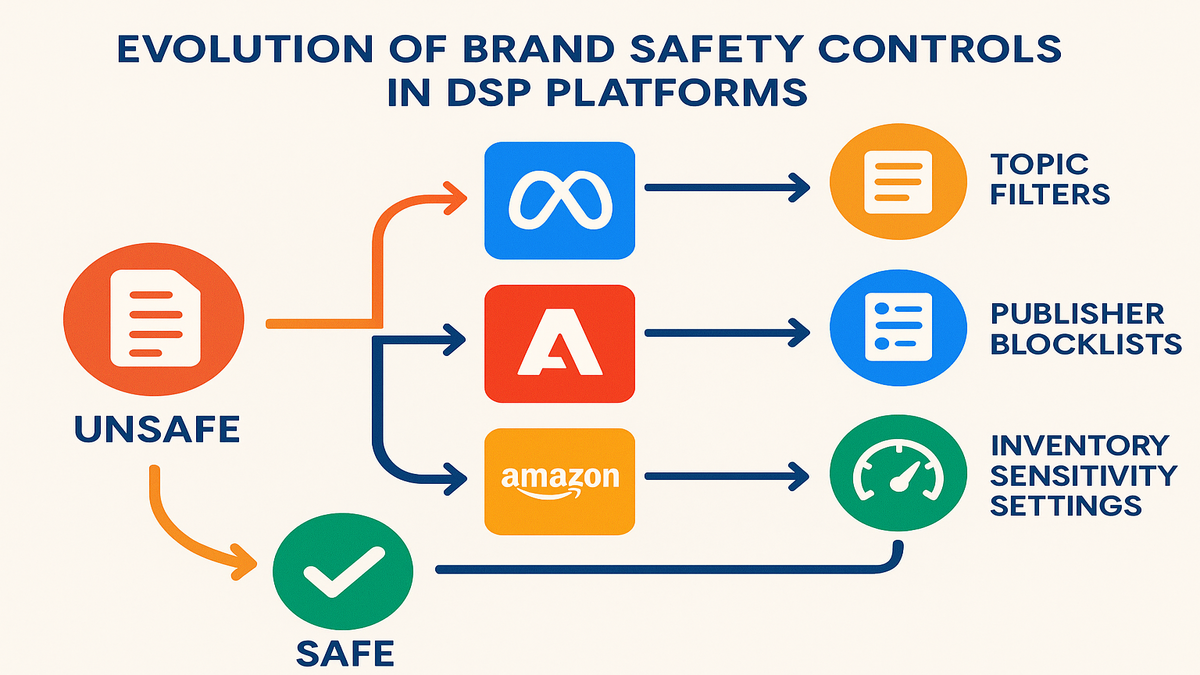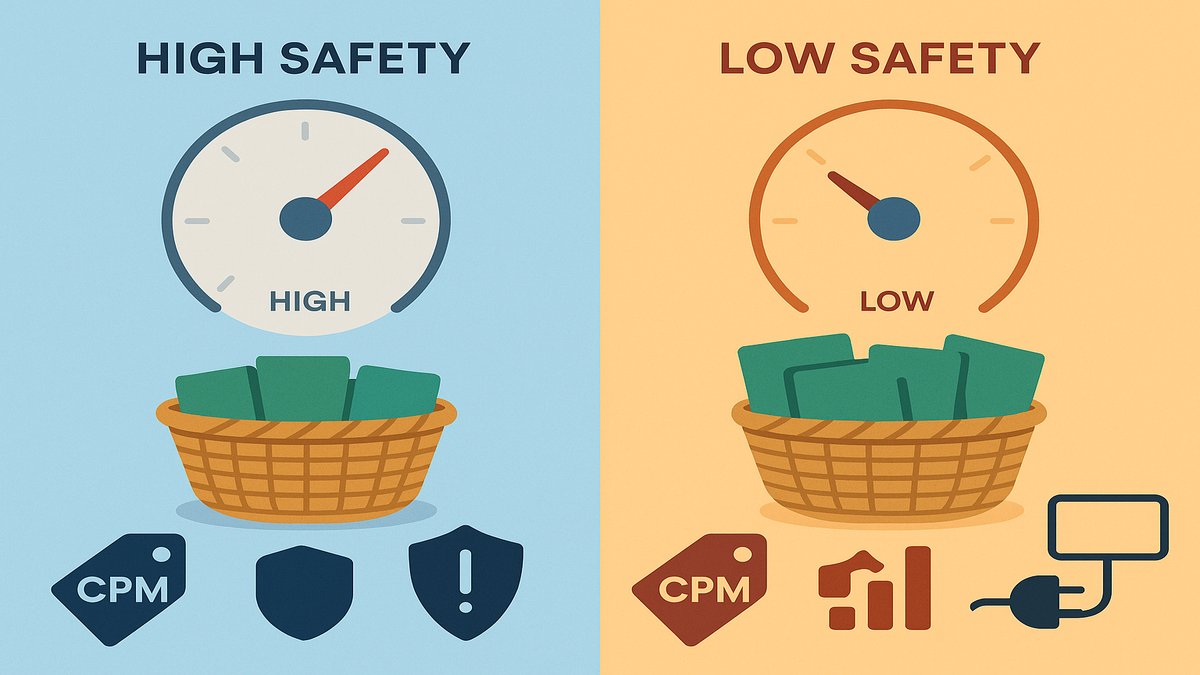
How DSP Brand Safety Beta Changes Your Ad Strategy Now

In 2024, brand safety is a nightmare waiting to happen. Ads can land next to wild conspiracy stuff or some live mess, and boom—one bad placement can trash years of trust. Suddenly, your CMO’s got coffee on their shirt and PR is in panic mode. So, brands are burning cash on every tool out there just to dodge these messes.
But here’s the bright side: what if you could avoid these traps before they bite you?
The latest open beta DSP safety settings are a real upgrade. Think of them like a custom seatbelt for your ads. You set how tight it holds, what counts as a red flag, and how much risk you’ll ride with. Every brand is different, so these new tools let you fine-tune everything.
Big DSPs—like Adobe, Meta, and Amazon—are rolling out tools that give advertisers almost pixel-level control. It’s not just “click safe and pray” anymore. Now, you can pick your vibe, choose the right partners, and let smart algorithms keep your brand clean—even when you’re asleep.
If you’re running, selling, or building digital ads, pay attention. This isn’t just another news blip. Take control before your rivals do. Let's dive in and make sense of it all, so you’re ahead instead of left catching up.
Key Takeaways
- Open beta DSP tools hand you tight control over where your ads show up.
- Name custom goals and give them smart weights for better results.
- You can now test direct links to pros like DoubleVerify and IAS during the beta.
- There’s a cost: more safety means higher ad prices and fewer spots.
- It’s not perfect—get ready for buggy interfaces, slow reports, and shifting features.

Defining Brand Safety
Why Suitability Matters
Let’s rewind. Not long ago, brand safety was buried in some IT checklist. Then came 2020—protests, pandemic, viral overload. Suddenly, ad placements became central. One off ad, and you were trending for all the wrong reasons.
That woke everyone up. Meta dropped its Brand Safety and Suitability Center to help folks dodge drama before it starts. Adobe’s DSP launched custom-named goals. You decide what “safe” means. Amazon’s been measuring not just views, but actual brand lift in safer spots.
A single misplaced ad can undo months of work. You’d rather spend hours making it right than weeks fighting bad press. — Tim Hwang, Author, 'Subprime Attention Crisis’
Now, it’s smart prevention up front, not lucky guesses.
DSP Safety Controls
Brand safety settings aren’t magic wands. They’re practical switches and filters—peace of mind for your campaigns. Here’s the usual:
- Block certain topics: Out with violence, adult stuff, hate, and toxic politics.
- Stoplist troublemakers: Ditch sites or publishers that make you queasy—or don’t line up with your values.
- Change inventory sensitivity: Go "Expanded" for reach (riskier), "Limited" for max safety.
Each DSP does it their own way. Meta’s got inventory filters—moderate, limited, expanded—for balancing risk and reach. Adobe leans into custom campaign goals that kick up optimization. Amazon’s thing? It hooks right in with outside verifiers and flags sketchy placements fast.
Running fancy cross-platform campaigns? Bringing in a pro like the DSP Services team saves you headaches while keeping control.
Beta Safety Controls
What’s New
So, what’s hot in the open beta? Early access to tools that may still be a little rough. Here’s what’s rolling:
- Top-level or ad group safety: Set safety rules for your whole brand or drill way down by campaign. Broad guardrails or super-fine filters—it’s your call.
- Custom goals = smarter algorithms: Define what matters (like avoiding scandal news or chasing super-loyal customers). The platform’s AI adapts in days.
- Super easy filters: Block whatever you hate—zombie flicks, internet jokers, whatever—with one click.
- Third-party safety checks: Plug in tools like Integral Ad Science or Peer39 for early warnings. You even get a unique "Brand Safety ID" tied to your rules.
Beta = changing your tires on a moving car. Cool new stuff, but don’t be surprised by the occasional glitch.
Reach Versus Risk
Safer ads mean fewer spots. Why? Most online content isn’t exactly family friendly. That shrinks inventory, nudging ad costs (CPM) higher. But the reward: less drama and way fewer crisis calls from legal.
Meta’s slider—Expanded, Moderate, Limited—lets you choose. Go wide for big reach and lighter costs. Go tight for full control and restful nights.
Inventory isn’t a light switch, it’s a dimmer. Set the mood for your brand. — Jenna Reardon, Spark Foundry
Early Adoption
Early Bird Perks
Getting in on the beta means:
- Set up first: Build your system before the crowd.
- Voice counts: Your feedback steers real changes.
- Catch bugs early: Better to spot (and fix) issues up front.
- Clearer reports: Custom deep-dives on where your ads landed and how safety settings changed results.
It’s like getting cheat codes. Early birds don’t just grab the worm—they pick what flavor.
Beta Bumps
Chances are, you’ll hit:
- Weird UIs: Button names or filters tend to move around. Keep support docs handy.
- Slow, spotty reports: Data might trickle in or miss details.
- Old and new clash: Fancy new safety rules can mess with legacy settings.
- Unstable features: Tomorrow’s update could break today’s trick. Always have a backup plan.
Bottom line: Experiment, keep records, and keep your most important campaigns running on safe, proven rules.
The Big Names
Meta
Meta makes it easy to stay clean. With their Brand Safety and Suitability Center, you can:
- Set risk levels for News Feed and In-Stream
- Block certain publishers or Facebook Pages
- Hook in with verifiers like DoubleVerify
You handle all this in one place. Pick topics to avoid—news, politics, trending chaos—by flipping a switch. Their inventory slider (Expanded, Moderate, Limited) rules. Go wide for reach or narrow for safety.
Adobe DSP
Adobe treats safety like a numbers puzzle. You prefix campaigns with "ADSP_" then let algorithms do the math. They weigh each conversion to keep things safer and more effective.
Adobe’s ties to IAS and Peer39 are strong. Not just checkbox security—real layers to stop anything sneaky from sliding by.
Amazon
Amazon DSP is all about measuring everything. Safety tools tie right into Brand Lift Studies and Attribution. You see not just “did we win?”, but also “did we stay safe?”
You get near real-time updates on where ads went and can yank bad placements before trouble starts.

Quick Recap
- Custom goals & smart weights: Smarter optimization that fits what you care about.
- More filters, less space: Extra safety usually means fewer places and higher costs.
- Beta bugs: UI goofs, slow data, and weird changes happen.
- Plug-and-play tools: Hook up third-party checks fast and easy.
- Transparency wins: Stay close to your logs—often.
Reporting
AI & Reporting
Forget hopes and prayers. Modern DSPs use AI to auto-tweak your bids and filters. Want safer conversions? Nudge your goal, and AI shifts spend right away.
Reporting is sharper, too. No more black boxes. Amazon DSP shows you where every ad ran, with breakdowns on who saw it and how each placement did. Whitelists, blacklists, and logs are all downloadable.
Beta reports aren’t perfect, though—expect delays, missing charts, and things changing often. But the cool thing? Your feedback actually helps. Spot a glitch? Report it. Devs watch and update fast.
Third-Party Verifiers
DSP filters are useful, but real pros use DoubleVerify, Peer39, or IAS. These tools scan every site or app before you bid. It’s extra insurance, zapping bad placements before they cause harm. If you’re in a risky space, these are must-haves.
FAQs
Q1: Brand safety vs. suitability—what gives?
Brand safety is about blocking the worst (violence, hate, adult stuff). Suitability means matching your unique tastes and customer base. Think: basic health vs. custom fragrance.Q2: How does AI make open beta settings smarter?
AI tweaks things for you—makes bidding, filters, and adjustments using campaign data. More data, better tuning.Q3: Isn’t all this filtering going to nuke my reach or spike my costs?
Kind of. Tighter filtering means higher costs, less inventory. But your ads land where you want them, minus drama. It’s an investment in trust.Q4: Who’s supporting these beta features now?
Meta, Adobe, and Amazon DSP are leading. Others are likely coming soon.Q5: How slow is the beta reporting and does it matter?
Usually daily or weekly, not instant. Slow updates mean risky placements can slip through, so check in often.Q6: Where do I give feedback or report beta bugs?
Most DSPs have built-in channels and forums. Beta feedback moves up fast—flag whatever’s off!
Master DSP Safety
- Use custom goals (think "ADSP_") so optimization is smart from Day 1.
- Pick the right inventory setting (Expanded, Moderate, Limited) for the trust vs. reach you want.
- Block any topics, publishers, or placements that clash with your brand.
- Turn on third-party checks (IAS, DoubleVerify, Peer39) for extra safety.
- Look at delivery logs and reports every week.
- Write down every change and give fast feedback when things get weird.
Follow these and your next campaign will land somewhere safe—without ugly cleanups after.
You want results, not crisis meetings. Open beta safety tools are your best bet. Dive in, test everything, and get your setup tight before others show up.
Want your reporting even easier? Try AMC Cloud for all your data and audience building in one spot.
Looking to prove those safe placements are actually working? Check out Amazon Attribution or dig into brand lift studies to see real benefits from going safety-first.

